Adolf Eichmann did not have a plan B. He did not collect money and did not prepare an escape route in the event of the Third Reich's defeat. On top of that, as a mass murderer, he had millions of fierce enemies dreaming of capturing him. How did he successfully avoid capture over the years?
The end of the war found Eichmann, the author of the "Final Solution of the Jewish Question", in the Austrian mountains, where he was organizing a partisan detachment. Faithful to his superiors until the end, he assumed that he would be able to harass the Allies for at least a month. Meanwhile, on May 8, his subordinates were dismissed from service, and he literally had nothing to do with himself.
As Neal Bascomb writes in his book "Tracking Eichmann", the German: For the first time in his life he had no orders to follow or leaders to follow. She felt like a ship without a rudder.
The SS-Obersturmbannführer (SS lieutenant colonel) was aware that the Allies considered him a war criminal. His companions, with whom he intended to hide in the mountains, also knew about it. They quickly let him know that he was not welcome among them.
He was left alone with his personal secretary, Rudolf Jänisch. All he had was his own cunning. And so he developed these seven infallible principles…
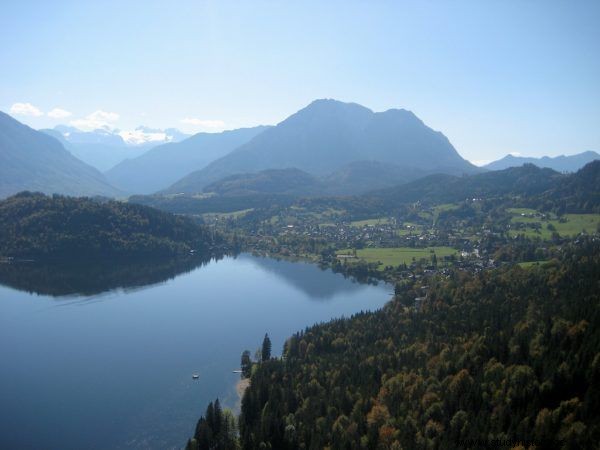
Altaussee lake and the village of the same name. It was here that Eichmann received his final order:to organize a partisan detachment in the mountains (photo:Taranis-iuppiter, CC BY-SA 3.0).
First:Change Identity
This is obviously a cliche. If you are high on the wanted list and there are soldiers everywhere who can identify you, get rid of your documents and change your name. It is better to have replacement papers in advance, but our hero thought about it too late. After all, he believed in the victory of the Third Reich until the end.
He wandered around the country for several days, trying to get to Germany. He pretended to be a Luftwaffe Corporal, whom no one had reason to arrest. Eventually, however, an American soldier searched him thoroughly and found a blood type tattoo on his forearm, like every SS man wore. Adolf tried to smoke it but failed. He removed it for good a bit later.
So far, he was sent to a POW camp and there he assumed a new identity. He didn't pick her at random.
Second:Choose the correct name
He introduced himself as Otto Eckmann - the name was supposed to be similar enough to automatically respond to it and he might just be mishearing if he turned around when he heard "Eichmann".

This article was based on Neal Bascomb's book, "Track Eichmann. The pursuit of the greatest criminal in history ”, Znak Horyzont 2015.
He chose a date exactly one year later than the real date as the date of his birth which was easy to remember.
He also claimed that he was born in Wrocław - he knew that all records were most likely burned there during the defense of the city.
Third:Destroy the photos
It's hard to escape the whole world if everyone knows what you look like. Eichmann thought of this one during the war. He did not allow himself to be photographed, he used only one official photo, the negative of which had been destroyed. Neither his wife nor his parents had a single image of him.
Today it's harder to imagine such an eventuality, but if you get under someone's skin, better control what you post on Facebook.
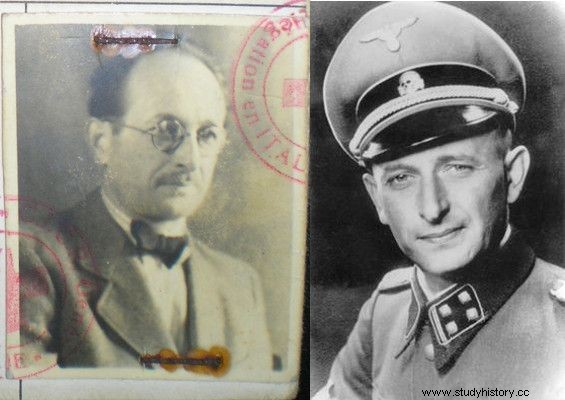
When Eichmann fled to Argentina, he no longer looked much like a young SS officer during the war (on the left, a photo from his passport issued by the Red Cross, Fundacion Memoria del Holocausto, public domain).
Eichmann was very different from other SS men in this respect. Not only did he not take commemorative photos of himself during the execution, but also did not take part in public games such as attempts to shoot two Jewish heads with one bullet.
He avoided showing himself to his victims, thanks to which few people knew what he looked like after the war.
Fourth:Don't trust lovers
Women have repeatedly turned out to be the greatest weakness of high-ranking men. During the war, Eichmann almost did not see his wife and three sons, but he did not avoid romances. Veronika Liebl, who was married to him, was aware of these betrayals, but remained faithful to him. Anyway, she was unable to help the investigators find the husband who had not been in contact with the family.
Of course, the hiding Eichmann did not meet with any of his former lovers and did not seek help from them. And rightly so, several of them were tracked down by Jewish Nazi hunters looking for him.
The German could not, however, correct the old mistake. Another of his "friends" lived near Linz, with whom he had accidentally left his photo.
The woman did not sin with intelligence, and perhaps that was why Eichmann did not see her as a threat. But Maria Mösenbacher was very proud of her lover's photos and liked to show them off. She also showed it to an agent of the Haganah - a Jewish paramilitary organization pursuing the Nazis - who made acquaintance with her only to extract this memento from her.
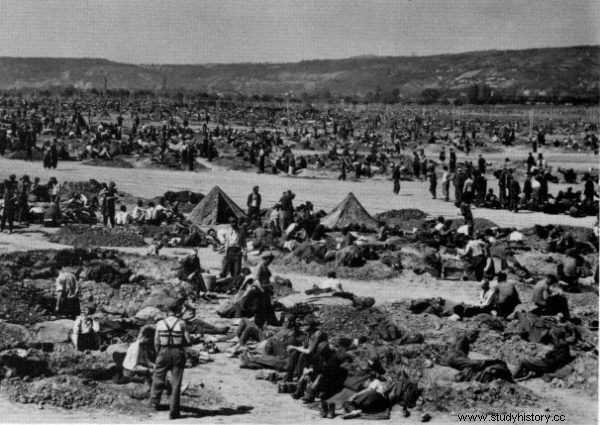
The conditions in the Allied camps for German prisoners of war in 1945 were terrible. Adolf Eichmann was a prisoner of many of them (photo:U.S. Army, public domain).
Fifth:Find Friends
Although revealing your identity to anyone is extremely risky, when you are a wanted criminal, sometimes there is no way out. After six months in the Allied POW camps, Eichmann remained unrecognized, but he realized that he would eventually be discovered. He had to trust someone.
He turned to the highest-ranking SS man in the camp. He, along with other officers, organized his comrade's escape. They forged documents in his new name, and one of them gave him a letter to his sister, who later helped him to sew in.
Eichmann hid in Lower Saxony for over four years, first as a lumberjack, then as a chicken breeder. He even sold eggs to Jews from Belsen, where one of the concentration camps was located during the war . Eventually, he wanted a better life and had to seek help again.
Sixth:Read newspapers
Through an encrypted advertisement in a newspaper, he communicated with a network of former SS-men from the ODESSA organization. It dealt with the transfer of Nazi criminals to Argentina, with the considerable help of the representatives of the Catholic Church. It was ruled by Juan Perón, who considered helping the pursued Germans as his duty.
As Neal Bascomb adds in the pages of the book "Tracking Eichmann":
Eichmann was one of many whose escapes were arranged around the same time. Apart from him , the "angel of death" Josef Mengele, the "butcher from Riga" Eduard Roschmann, the mass murderer Erich Priebke, the "merciful killer" of the mentally ill and handicapped Gerhard Bohne, among others, left Europe and the commandant of the SS, Josef Schwammberger, who is terrifying with his cruelty.
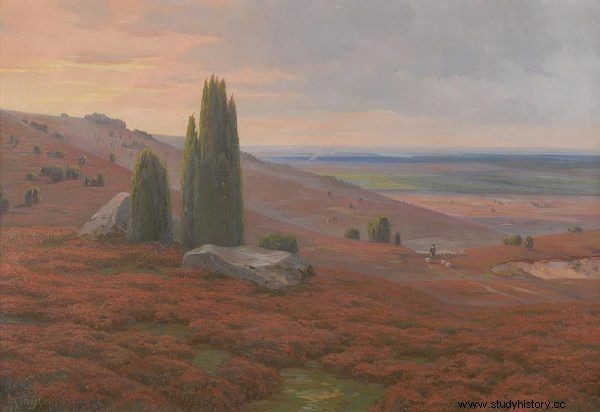
The Lüneburg Desert in Lower Saxony, where Eichmann hid for several years, is famous for, among others from its vast moors (painting by Arnold Lyongrün, public domain).
Seventh:Don't get over your honor
The German criminal came to Argentina in 1950 as Ricardo Klement, and two years later he dared to bring his family. His wife returned to her maiden name, but the sons still identified themselves as Eichmanns. Their father had pretended to be their uncle, but everyone would admit that it was at least careless. Indeed, this error turned out to be fatal.
In December 1956, one of Eichmann's sons visited the home of his girlfriend, Sylvia. He did not know that her father was half Jewish, a former Dachau prisoner who had escaped from Germany before the war. The young German proudly told that his father was a high officer of the Wehrmacht. He also expressed his regret that it was not possible to complete the extermination of the Jews .
Ricardo Klement often beat his "nephews" to remind them to keep their mouths shut. As it turned out, for free.
The girl's father quickly combined the facts, this is the boy's name with his views. He contacted Fritz Bauer, a German prosecutor of Jewish origin who often appeared as a prosecutor of Nazi criminals. The latter, in turn, passed the information on to Israel's intelligence service. The loop around Eichmann began to tighten…
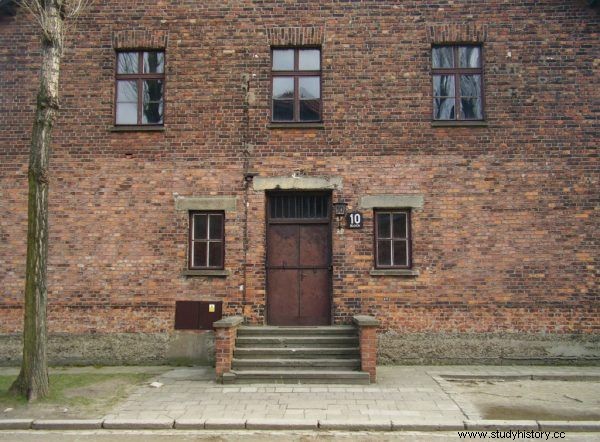
Block 10 in Auschwitz. It was here that Josef Mengele carried out his experiment, who fled to Argentina at a similar time to Eichmann. He was never caught (photo:VbCrLf, CC BY-SA 4.0).
But why did the criminal who had eluded the pursuit for so many years act so recklessly? In Argentina, he felt too confident that the search for him had already been abandoned. Most of all, however, he found it insulting that his sons could not admit who their father was . He wanted them to have at least their real names.
When a Mossad agent questioned Eichmann after his capture, while still in Argentina, he also inquired about the matter. The German responded indignantly: You don't think I would ask my family to lie because of me?
It was undoubtedly hypocritical, lies were the everyday life of the whole family of the criminal ... You can read about his fate in our other article. And also in the moving book by Neal Bascomb, the new edition of which has just hit bookstores.
Source:
Neal Bascomb, Track down Eichmann. The pursuit of the greatest criminal in history , Znak Horyzont, Krakow 2015.
